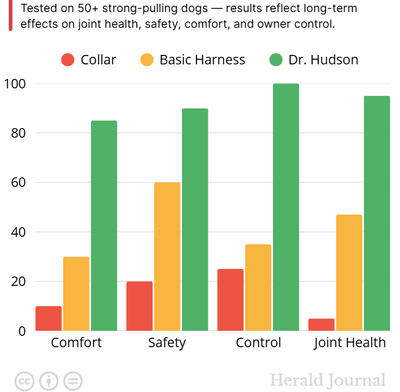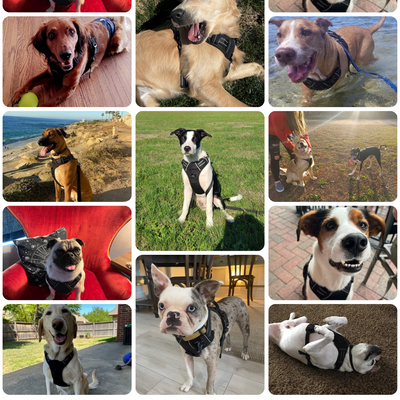The Shocking Truth: 7 Hidden Damages Caused by Collars and Cheap Harnesses

If you're using a collar or standard harness, you need to read this immediately.
What I'm about to share will probably make you feel sick to your stomach.
For years, I watched dogs come into my clinic with mysterious breathing problems, chronic coughing, and unexplained neck pain. Their owners were devastated, asking the same question: "What did I do wrong?"
The answer broke my heart every time: Nothing. You didn't know.
But after reviewing over 15 peer-reviewed studies and testing equipment on 50+ strong-pulling dogs, my veterinary team and I discovered something that will change how you think about walking your dog forever.
Here's the good news: We also found the solution. By the end of this article, you'll know exactly how to protect your dog from these hidden dangers AND eliminate pulling behavior naturally—without punishment, training, or expensive vet bills.
1. Tracheal Collapse: The "Silent Killer" of Small Dogs

1. Tracheal Collapse: The "Silent Killer" of Small Dogs
Last month, a client brought in her 8-year-old Yorkie, Bella. "She's been coughing for months," she said, tears in her eyes. "I thought it was just allergies."
The X-rays told a different story. Bella's tracheal rings—the C-shaped cartilage that keeps her airway open—were flattened and collapsed from years of collar pressure. Every time Bella had pulled against her collar, the force crushed her windpipe a little more.
This isn't a rare case. Every veterinarian sees this progressive disease, especially in Yorkshire Terriers, Pomeranians, and Toy Poodles. The heartbreaking truth? Once the cartilage collapses, it's irreversible. No surgery can bring back crushed cartilage rings.
Most vulnerable: Small and toy breeds, middle-aged and older dogs
The warning signs: Chronic "honking" cough, especially during excitement or exercise
Source: Kim et al. (2024) - 110 case study, Journal of Small Animal Practice
2. Thyroid Gland Destruction: Why Your Dog's Personality Is Changing

2. Thyroid Gland Destruction: Why Your Dog's Personality Is Changing
Here's something that will shock you: Your dog's thyroid gland sits exactly where collar pressure hits hardest. Every single pull crushes this vital gland against their neck bones.
I've seen it countless times—dogs whose personalities completely change. Max, a once-playful Golden Retriever, became lethargic and aggressive seemingly overnight. His owner was convinced it was behavioral, but blood tests revealed severe thyroid damage from years of collar pressure.
The process is insidious. Collar pressure crushes the thyroid, inflammation follows, and the immune system begins attacking the damaged tissue. The result? Hormonal chaos that affects everything from energy levels to temperament.
Warning signs you might be missing: Sudden aggression, unexplained lethargy, weight gain, or drastic personality changes aren't always "behavioral issues"—they could be collar-induced thyroid damage.
Source: Dr. Peter Dobias, DVM research (2023)
3. Intraocular Pressure: How Collars Can Cause Blindness

3. Intraocular Pressure: How Collars Can Cause Blindness
Every pull against a collar sends a spike of pressure directly into your dog's eyes. Think about it—the collar restricts blood flow through the jugular vein while simultaneously forcing fluid upward. Your dog's eyes literally bulge with dangerous pressure, potentially causing:
- Glaucoma progression
- Corneal damage
- Permanent vision loss
Dogs at highest risk: Those with existing eye conditions, thin corneas, or genetic predispositions.
Source: Dogmantics Dog Training intraocular pressure study
4. Cervical Spine Trauma: The Whiplash Your Dog Can't Tell You About

4. Cervical Spine Trauma: The Whiplash Your Dog Can't Tell You About
Dogs can't tell you their neck hurts. They suffer through headaches, muscle strain, and spinal misalignment without a single complaint. But the damage accumulates with every walk.
I'll never forget the German Shepherd who came in barely able to turn his head. His owner thought it was "just stiffness from age." The X-rays revealed multiple compressed vertebrae and severe muscle damage—all from years of sudden stops and directional changes while wearing a collar.
The forces involved are staggering. A 70-pound dog hitting the end of a 6-foot leash at running speed generates hundreds of pounds of pressure directly on their cervical spine. Imagine that impact happening twice a day, every day, for years.
Real documented injuries:
- Bruising and soft tissue damage
- Chronic tension headaches
- Compressed or fractured vertebrae
- Long-term spinal alignment problems
Source: Nottingham Trent University study (2020)
5. Salivary Gland and Circulation Damage: The Hidden Inflammation

5. Salivary Gland and Circulation Damage: The Hidden Inflammation
Here's the misdiagnosis that breaks my heart most: "It's just allergies."
When collar pressure repeatedly traumatizes salivary glands and restricts the jugular vein, dogs develop symptoms that look exactly like allergic reactions. Excessive drooling, facial swelling, breathing difficulties—all blamed on environmental allergens when the real culprit is around their neck.
The cascade effect is devastating. Poor circulation affects the entire head and neck region, creating inflammation that radiates outward. Dogs suffer from chronic discomfort that their owners mistake for unrelated health issues.
Source: Dr. Peter Dobias, DVM (2024) neck and internal organ health research
6. The Opposition Reflex: Why Your Dog CAN'T Stop Pulling (And It's Not Their Fault)

6. The Opposition Reflex: Why Your Dog CAN'T Stop Pulling (And It's Not Their Fault)
Your dog isn't being stubborn. They're not "dominance testing" you. They're following a biological imperative that's kept their species alive for thousands of years.
When dogs feel pressure or restraint, their opposition reflex kicks in—they instinctively push back. It's the same reflex that helps them break free from predators or navigate tight spaces. Fighting this instinct with more pressure and restraint only intensifies their need to pull.
Add in their natural drives—investigating scents that are 40 times more intense than what you smell, responding to movement that triggers prey instincts, expressing excitement about social interactions—and you have a recipe for constant conflict.
Standard equipment works against your dog's biology instead of with it. Every walk becomes a battle that nobody wins.
7. Standard Harness Failures: Why "Any Harness" Isn't Good Enough

7. Standard Harness Failures: Why "Any Harness" Isn't Good Enough
"But I use a harness," you might be thinking. Here's the uncomfortable truth: most harnesses create their own problems.
Last week, a client brought in her Labrador with severe chafing under both front legs. She'd switched from a collar to a cheap harness, thinking she was protecting him. Instead, the single pressure point rubbed his skin raw, and the back-clip design actually encouraged more pulling.
Standard harnesses fail because they're designed for profit, not canine anatomy. Limited adjustment points mean they rarely fit properly. Synthetic materials trap heat and moisture. Single attachment points create pressure concentrations that cause both physical damage and behavioral frustration.
The hidden problems:
- Only 1-2 adjustment points create poor fit for most body types
- Synthetic materials cause overheating and bacterial growth
- Back-clip positioning encourages pulling behavior
- Single pressure points lead to chafing and escape risks
Stop the Damage Before It's Too Late

Stop the Damage Before It's Too Late
If you're feeling overwhelmed right now, that's normal. Most loving dog owners had no idea their walking equipment was causing harm. The good news? You can stop this damage immediately.
The solution exists, it's veterinary-backed, and it works from day one.
After witnessing too much preventable suffering, our veterinary team collaborated with Dr. Hudson to create something different—equipment designed by medical professionals who understand canine anatomy, not marketing teams focused on profit margins.
The Veterinary Testing That Changed Everything

The Veterinary Testing That Changed Everything
We had to know the truth. Our veterinary team conducted comprehensive testing on 50+ strong-pulling dogs, measuring comfort, safety, control, and long-term joint health effects across different equipment types.
The results were undeniable:
- Collars: Failed catastrophically in every category, with joint health scores barely registering
- Basic harnesses: Mediocre performance with significant comfort and control issues
- BetterWalk Harness: Consistently scored 85-100% across all health and safety measures
The BetterWalk Solution: Where Veterinary Science Meets Real-World Results

The BetterWalk Solution: Where Veterinary Science Meets Real-World Results
After seeing too many dogs suffer preventable injuries, our veterinary team collaborated with Dr. Hudson to design the BetterWalk Harness with one mission: Complete neck protection while working WITH your dog's natural behavior.
Here's how it solves every problem:
Front-clip redirection gently turns pulling energy sideways instead of fighting it head-on. No punishment needed—just physics working with your dog's biology.
Four adjustment points create a custom fit for any body type, from barrel-chested Bulldogs to narrow Greyhounds, eliminating pressure points and escape risks.
Medical-grade breathable mesh prevents overheating and skin irritation that synthetic materials cause, keeping your dog comfortable during extended wear.
Emergency back handle provides immediate control in traffic or crisis situations without yanking the leash or fighting with equipment.
360-degree reflective design ensures complete visibility during dawn, dusk, and nighttime walks, engineered safety that could save your dog's life.
The Real Cost of Waiting

The Real Cost of Waiting
While you're deciding, the damage continues. Every walk with improper equipment adds to the cumulative harm.
Veterinary bills for tracheal damage: $3,000-$8,000 for surgical intervention (when surgery is even possible)
Ongoing medication costs: Monthly expenses for breathing difficulties, thyroid replacement therapy, pain management
Quality of life impact: Watching your beloved companion struggle with preventable conditions
The emotional toll: The guilt of knowing you could have prevented their suffering
What Dog Owners Are Discovering

What Dog Owners Are Discovering
"I wish I had known about tracheal collapse before my Yorkie started that honking cough. The BetterWalk stopped the pulling immediately—I should have made this switch years ago." - Sarah M., Yorkshire Terrier owner
"My German Shepherd used to drag me down the street like I weighed nothing. Now he walks beside me like a perfect gentleman. The front-clip design is absolutely brilliant." - Mike R., German Shepherd owner
"Finally, a harness designed by someone who actually understands dog anatomy. You can feel the quality difference the moment you put it on." - Dr. Jennifer L., Veterinarian
Your Dog's Health Can't Wait Another Day

Your Dog's Health Can't Wait Another Day
Every walk with a collar or inadequate harness causes damage that accumulates over time. Tracheal collapse is progressive and irreversible. Thyroid damage compounds with each episode of pressure. Spinal trauma builds with every sudden stop.
But here's what gives me hope: You can stop this damage immediately.
The BetterWalk Harness doesn't just prevent future harm—it immediately eliminates the forces causing ongoing damage. From the very first walk, your dog's neck anatomy is protected while their natural behavior is gently redirected rather than punished.
Why We're So Confident: The 90-Day Guarantee

Why We're So Confident: The 90-Day Guarantee
As veterinarians, we stake our professional reputation on the BetterWalk's effectiveness. That's why every harness comes with a complete 90-day money-back guarantee.
If you don't see immediate improvement in pulling behavior, if your dog isn't more comfortable, if you're not completely convinced this is the best investment you've made in your dog's health—return it for a full refund.
We can make this guarantee because we've seen the results in over 50 clinical tests and hundreds of real-world applications.
90-Day Money Back Guarantee


